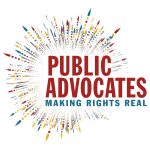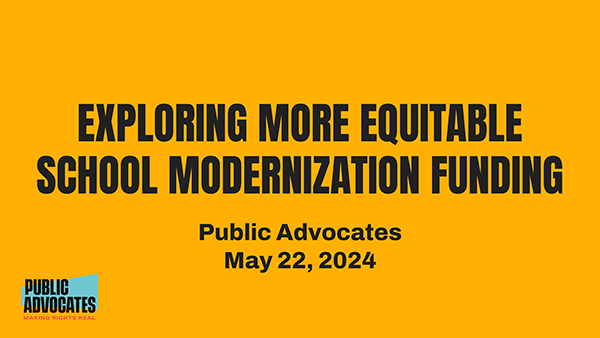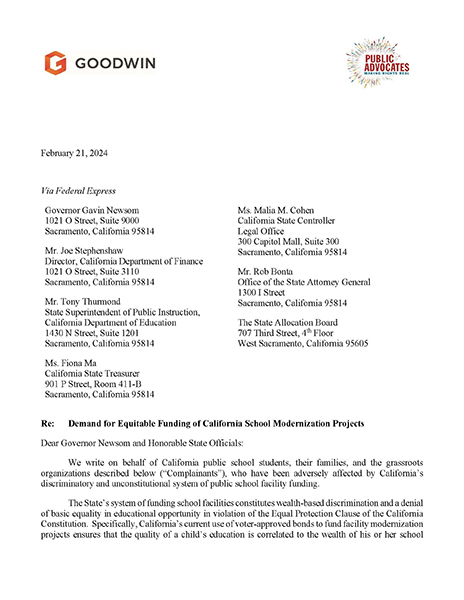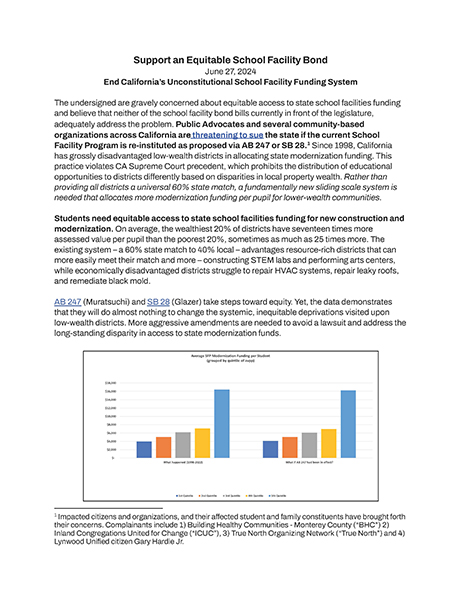Public Advocates, with pro bono counsel Goodwin Procter LLP—and impacted students, families, residents, and grassroots community organizations—have sent a demand letter to the California governor and various state officials and agencies, urging them to end grossly unequal and unconstitutional disparities in the state’s school facility funding program.





Summary:
On February 21, 2024, Public Advocates, along with pro bono counsel Goodwin Procter LLP—and impacted students, families, residents, and grassroots community organizations from across the state—sent a demand letter to the California governor, and various state officials and agencies, demanding them to end the state’s highly discriminatory system for funding school facilities—or face a lawsuit challenging this fall’s anticipated state school construction bond.
California’s system of funding school facility modernization projects through local and state bonds is based on district wealth. Not only do low-wealth school districts have less access to local bond revenue compared to their wealthier neighbors, but they also have less access to state modernization bonds as a result. The current system is structured to provide all districts with a 60% state match, regardless of need, thereby advantage wealthier districts which have exponentially greater ability to raise local funds, which in turn are matched by the state in greater amounts. Districts with lower funding streams and smaller tax bases report higher levels of facility deficiencies, which directly impacts the quality of education. The result is an unequal system in which students in low-wealth districts receive an education inferior to that of their peers in higher-wealth districts in violation of California’s Equal Protection Clause.
- If District A raises $10 million to modernize and repair school facilities, the state will provide $15 million in matching, which gives District A $25 million in funding.
- If District B raises $80 million to modernize and repair school facilities, the state will provide $120 million in matching, which gives District B $200 million in funding.
Studies show that school facilities impact student engagement, learning, school climate, and health. School modernization needs, such as updating HVAC systems, repairing leaking roofs, upgrading electrical systems, and replacing old portables are considerable across the state—especially because California has not issued a state bond for school facilities since 2016. School facility modernization needs disproportionately impact low-income communities of color who historically have had less resources to modernize their facilities and, as such, often disproportionately experience greater levels of disrepair.
The complainants of our demand letter are calling on state leadership to take immediate action to remedy this unconstitutional school facility funding system and significantly modify the state’s modernization program during the current legislative term in advance of the November bond measure or face legal action.
Our Position on Prop 2:
Public Advocates has no current position on Proposition 2, a bond measure that would borrow $10 billion to help modernize schools and support construction costs, but maintains a discriminatory system of funding that prioritizes higher wealth students and districts. We recognize the tremendous need for investment in our public school facilities, but remain concerned that this funding will not reach the low-income students of color in low-wealth districts that need it most.
Public Advocates opposed AB 247, the bill that created Proposition 2 for the November 2024 ballot. As we stated in our February 2024 demand letter to state leadership, the distribution of bond money would continue the inequitable, and in our view, unconstitutional school facility financing system that privileges the rich and disinvests in low-income communities of color. In our letter and subsequent materials to leadership we proposed more equitable solutions including but not limited to replacing the current universal matching system for modernization funds with a sliding scale and increasing supplemental hardship funding.
While we recognize the tremendous need for an education bond, we remain concerned about the inequitable distribution of these funds that continues to prioritize wealthier districts—and the students who live in those districts—over high needs districts even when you take the hardship program into account.
As study after study has demonstrated, over the past 25 years, California’s universal 60% match for modernization funds has delivered more than 4 times as much state bond funds per student to wealthy districts as low-wealth districts. This bill provided equity in name only and treats students differently based on the wealth of their community. By supporting such a bill that doubles down on maintaining a discriminatory system, our state leadership has sent a message to low-wealth communities from Del Norte to Salinas to Lynwood to San Bernardino that they do not care if students in these communities are educated in substandard facilities.
Given that we believe it maintains an unconstitutional structural flaw, Public Advocates cannot support Proposition 2. We are, however, also not taking a formal position in opposition to the Proposition given the tremendous, long-unaddressed need for additional capital support for facilities in California. We believe the voters should weigh these important considerations as they decide for themselves whether or not to support Proposition 2.
Resources:
PA Statement on Proposition 2, the Public Education Facilities Bond Measure (2024)
View our presentation to members of the state legislators on this issue.
Read Media:
- EdSource: Can Prop 2 fix California’s most neglected school buildings?—October 17, 2024
- San Diego Tribune: California voters could give schools $10 billion. How much would it help San Diego County — and how fair is it?—July 22, 2024
- Local News Matters Bay Area: It’s been 8 years since California voted for a school construction bond — will this one fly?—July 10, 2024
- California Black Media (Suitelife Social): Capitol News You May Have Missed—July 8, 2024
- Epoch Times: 加州百亿美元教育建设债券计划 11月将公投—July 6, 2024
- Los Angeles Times: Your Guide to Proposition 2: Education Bond—July 5, 2024
- AP Newswire: California Legislature Votes to Ask Voters for Permission Borrow $20 Billion for Climate, Schools—July 3, 2024
- Pasadena Now: California Legislature Makes a Flurry of Big Changes to November Ballot Measures—July 2, 2024
- News from the States: Does a proposed $10 billion bond favor richer California school districts?—July 2, 2024. This story was reprinted in The 74, KQED, KPBS-FM (Espanōl), GV Newswore, and Sign on San Diego, a newsletter of the San Diego Union Tribune.
- Politico [Pro]: Democratic Leaders Agree to $10B Bond for California Schools and Community Colleges—July 2, 2024
- EdSource: A hearing, a unanimous vote and a preview of litigation over a school construction bond—July 2, 2024
- Mountain View Voice: Los legisladores de California llegan a un acuerdo sobre un bono escolar de 10 mil millones de dólares—July 1, 2024
- EdSource: $10 billion school construction bond headed to Nov. 5 ballot: what’s in it?—July 1, 2024
- Los Angeles Times: California Voters Could See Schools Bond and Historic Climate Initiative on November Ballot—July 1, 2024
- CalMatters: Lawmakers reach agreement on $10 billion school bond—June 30, 2024, Reprinted on LAist on June 30, 2024 and in The Salinas Calfornian on July 2, 2024
- EdSource: Fighting for fair school construction funding in California—June 27, 2024
- EdSource: Behind the scenes, a battle looms over fair funding for school construction—June 18, 2024
- IE Community News: San Gorgonio Alumnus Angel Orozco Champions Crusade for Enhanced Funding to Mitigate Harsh SBCUSD Learning Environments—February 29, 2024
- Wild Rivers Outpost: Del Norte Parents Join Effort to Change California’s School Facilities Funding Distribution; Nonprofit Law Firm Says It Will Challenge Statewide Bond Measure if Demands Aren’t Met—February 23, 2024
- Ed Source: Property-Poor Districts Demand Fairer Funding for School Facilities—February 22, 2024






